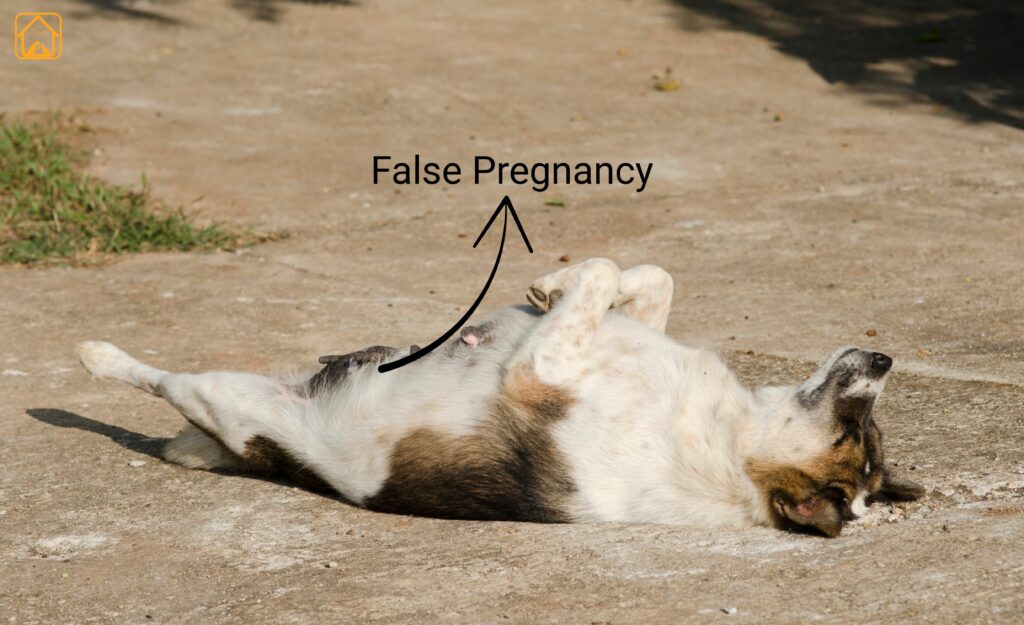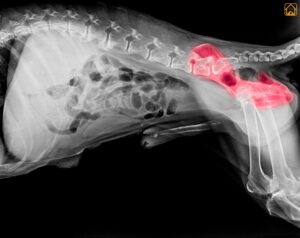What Is Dog Phantom Pregnancy (False Pregnancy)?
Dog phantom pregnancy is a natural condition where a female dog shows both physical and behavioral signs of pregnancy, despite not being pregnant. This can happen to dogs of any age after their heat cycle, especially if they haven’t been spayed. You might notice things like enlarged nipples, milk production, or even mothering behaviors, such as carrying toys around. The body is basically fooled by hormonal changes, leading your dog to believe she’s about to have puppies, even if she’s never mated.
What Causes Phantom Pregnancy in Dogs?
Hormones at Play
The main cause behind dog phantom pregnancy is a shift in reproductive hormones after your dog’s heat cycle. After estrus, progesterone levels drop quickly while prolactin rises, tricking your dog’s body into behaving as if she’s pregnant. This can occur whether your dog was mated or not. Curiously, even spayed dogs can sometimes show these symptoms if they were spayed during a certain phase of their heat cycle, when hormone levels are high. The science isn’t fully understood, but it’s a quirk of canine biology that shows up in most unspayed females at some point.
- Unspayed female dogs are most at risk
- Rapid hormone changes trigger symptoms
- Sometimes seen after spaying if timing overlaps with hormone surge
Honestly, the first time I saw my own dog start “nesting” after a heat, I was baffled. Turns out, it’s just nature playing tricks.
Signs and Symptoms of Phantom Pregnancy in Dogs
Physical Symptoms
- Swollen mammary glands or nipples
- Milk production or slight discharge
- Weight gain or bloating
- Lethargy or reduced energy
- Nausea or occasional vomiting
- Loss of appetite (sometimes not eating at all)
- Panting or shaking
Behavioral Signs
- Nesting, gathering blankets or making beds
- Mothering objects (like toys or shoes)
- Whining or restlessness
- Protective or even aggressive behavior
- Decreased interest in walks or play
Have you ever seen your dog protect a bunch of toys like they’re real puppies? That’s a common sign of a phantom pregnancy. Some dogs build little “nests” and act like they’re caring for babies. They might even growl or get upset if you try to take the toys away.
How to Tell the Difference: False Pregnancy vs Real Pregnancy
Telling the difference between a false pregnancy and a real dog pregnancy can be tricky. Both can cause similar signs like nesting, swollen nipples, and even milk production. But the biggest difference? Only real pregnancies have puppies growing inside.
If you’re certain your dog didn’t mate, chances are it’s a phantom pregnancy. Still, it’s best not to guess. A vet can confirm everything with an ultrasound or X-ray. If your dog is acting unusual or showing changes you’re unsure about, don’t wait it out, check with your vet to be sure and give your dog the care she needs.
Behavioral Changes: Whining, Nesting, and Aggression
Behavioral changes during dog phantom pregnancy can be surprising. Below are some common changes you can observe.
Emotional Whining
Your dog may start whining softly for no clear reason. It’s not just noise—she might be feeling confused or anxious, as her body thinks puppies are coming even when they’re not.
Nesting with Toys or Blankets
She could begin gathering her favorite toys, tucking them into beds or corners, and treating them like puppies. This nurturing behavior is instinctive and often deeply emotional for her.
Sudden Mood Swings
Some dogs show a short temper during this phase. If she growls or guards her “nest,” it’s not bad behavior, it’s her natural drive to protect what she believes are her babies.
Over-Attachment or Withdrawal
Your normally playful pup might either stick to your side like glue or retreat to a quiet spot. Both are her way of coping with the hormonal rollercoaster she’s unknowingly riding.
I’ve seen dogs become so devoted to their favorite plush toy, they treat it like a real puppy, complete with grooming and guarding. These behaviors are driven by hormones and usually fade with time, but they can test your patience and tug at your heartstrings.
How Long Does a Phantom Pregnancy Last in Dogs?
Dog phantom pregnancy symptoms usually start 4 to 9 weeks after your dog’s heat. Most cases last about 2 to 3 weeks, but in rare situations, symptoms can drag on for up to a month or more.
If your dog seems uncomfortable or her symptoms last longer than three weeks, a vet check is a good idea. The good news? Most dogs recover without lasting issues.
Treatment Options for Dog Phantom Pregnancy
Medical Support
Most mild cases of dog phantom pregnancy don’t need medication. Symptoms usually resolve on their own. However, if your dog is very uncomfortable, has severe milk production, or shows signs of infection like redness or swelling, your vet may suggest treatment. This might include:
- Medications like cabergoline to lower prolactin and stop milk production
- Anti-anxiety medication for severe restlessness or distress
- Protective bodysuits or cones to stop licking and prevent mastitis
- Spaying, to prevent future episodes (but timing is important, spaying during a phantom pregnancy can make symptoms last longer)
Never try to express or “milk” your dog’s mammary glands, it makes things worse by encouraging even more milk production.
Natural Remedies and At-Home Management
- Distract with extra walks and games, mental stimulation can help shift her focus
- Gently remove “mothered” toys while she’s outside or distracted (never punish or scold)
- Offer a nutritious, well-balanced diet to support her recovery
- Use a bodysuit or cone to prevent licking at nipples if needed
- Some pet parents find raspberry leaf (with vet approval) can help balance hormones, but always check with your vet first
Honestly, I found that keeping my own dog busy and gently removing her favorite “puppy” toys was the trickiest part. She pouted for a bit, but a treat-filled puzzle or a fun walk usually did the trick.
Honestly, what I did with my dog was gently remove her favorite “puppy” toys during her false pregnancy. She looked upset and pouted for a while, but I kept her distracted with treat puzzles and longer walks. Keeping her active and loved really helped her move on without stress.
Prevention: Spaying and Reducing Recurrence
The best way to prevent dog phantom pregnancy is to spay your female dog before her first or second heat. Spaying removes the source of hormonal swings that trigger false pregnancies. If your dog has or had repeated phantom pregnancies, talk to your vet about the safest timing for surgery. Spaying during active symptoms can prolong recovery. For most pet parents, spaying is a one-time solution to a recurring problem.
When to Contact a Vet: Warning Signs and Complications
Most dog phantom pregnancies are mild, but you should call your vet if you notice:
- Red, hot, or painful mammary glands (could be mastitis)
- Yellow, green, or foul-smelling discharge
- Refusing to eat or drink for more than a day
- Severe lethargy or distress
- Symptoms lasting longer than three weeks
It’s always better to play it safe, some complications, like infection or mammary tumors, need fast attention.
FAQs About Dog Phantom Pregnancy
Is false pregnancy in dogs dangerous?
Most phantom pregnancies aren’t dangerous, but sometimes complications like mastitis (mammary gland infection) or behavioral changes can arise. If your dog seems very unwell, always check in with your vet.
How long does a dog phantom pregnancy last?
Symptoms typically last 2–3 weeks, though some cases can go up to a month. If signs persist longer, or your dog seems uncomfortable, call your vet for guidance.
Can spayed dogs have phantom pregnancies?
It’s rare, but possible, especially if a dog was spayed during a certain point in her heat cycle. The hormone drop can still trigger symptoms. Usually, spaying prevents future episodes.
Should I take away my dog’s toys during a phantom pregnancy?
If your dog is mothering toys, it’s best to gently remove them to avoid reinforcing the behavior. Do this calmly, maybe distract her with a walk or treat, then move the toys while she’s not looking.
What natural treatment can help dog false pregnancy?
In mild cases, extra exercise, removing “puppy” toys, and a balanced diet can help. Some owners use raspberry leaf supplements, but always ask your vet before trying herbal remedies.
Why is my dog not eating, panting, or whining during a phantom pregnancy?
Hormonal changes can make dogs lose their appetite, pant, whine, or seem restless. If these symptoms are severe or ongoing, a vet visit is needed to rule out other issues.
How to help a dog during a phantom pregnancy?
Keep her calm and distracted, use a bodysuit or cone if she’s licking, and provide gentle reassurance. Most importantly, don’t punish her, she’s not in control of these instincts.
Conclusion
False pregnancy in dogs can be an emotional time for both you and your pet. While it often resolves on its own, your love, patience, and a bit of guidance from your vet can make all the difference. Stay observant, stay gentle, and remember this too shall pass, with care and calm.



